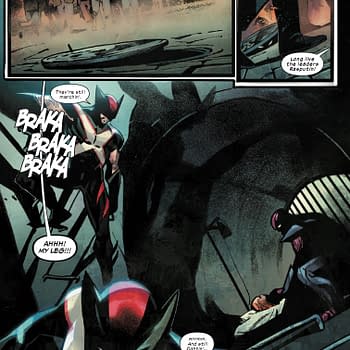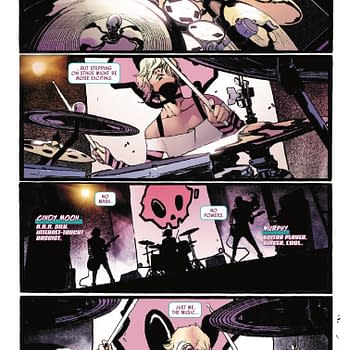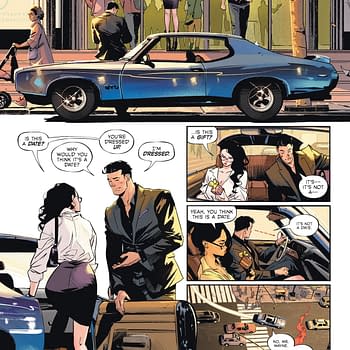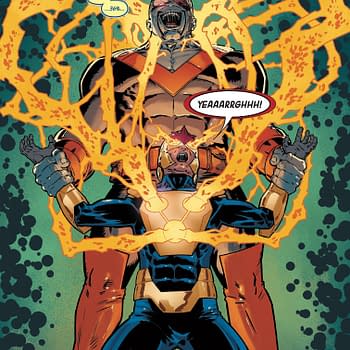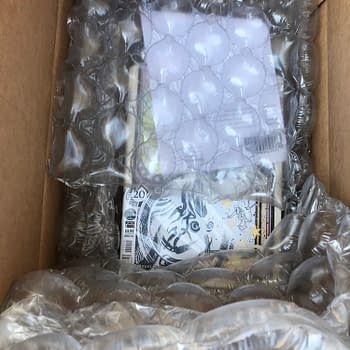Posted in: Comics | Tagged: betty boop, Comics, dynamite, entertainment, J. Bone, roger langridge
Empowering A 1930's Icon – Roger Langridge Talks Betty Boop
The return of 1930's animated icon Betty Boop continues as Roger Langridge talks about empowering the famous flapper while keeping the elements that made her a hit. Covers for the second issue of the new Dynamite series are by Langrdige and J. Bone.

ROGER LANGRIDGE: Well, just to clarify, to some degree it is an update; I've made an effort to make Betty as empowered a character as I can, and Gisele Lagace's artwork has a more modern feel than the original cartoons. But I think any successful update has to keep the things that made the property work in the first place.
As for what those might be: well, I think the 1930s atmosphere, and the slightly low-life aspects of that atmosphere in particular (speakeasies, jazz music), are pretty crucial. Some fidelity to the overall Fleischer visual aesthetic seems essential, as I think it's central to the property's appeal – the over-the-top ghost-train atmosphere, and something a little unsettling about the character designs (the black eyes and white faces, like horrific clowns). And a bit of the bonkers logic that characterizes the cartoon's plots goes a long way, too – hard to pull off in a narrative comic, but I hope there's at least a whiff of that. Beyond that, there's Betty's character herself, who (in my reading of the cartoons) is sexy but essentially chaste – that tension is the engine that makes her tick. None of this is from any detailed analysis, it's just my gut feeling, but that's where I think the cartoons were coming from.
BB: What can you tell us about the adventures of Betty in issue #2, publishing in November?
RL: A band of ghosts have been trying to take over Betty and Grampy's house to turn it into a speakeasy, and this time their ruse is to pretend to requisition the property for the government in order to turn it into a jazz center for widows and orphans. This, of course, is to cover plans of a much more nefarious nature, as they turn the place into a refuge for supernatural lowlife.
BB: Who are the "Department of Jazz"? Will we see Betty's friend, jazz great Cab Calloway?
RL: The Department of Jazz is a made-up government department, which is a good example of the bonkers story logic I think is an essential Fleischer element. They're the branch of the government responsible for swingin' tunes! As for Cab Calloway himself, he doesn't show up in person – after all, he's not a Fleischer character as such – but his cartoon stand-in in our stories is the Oop-A-Doop Club's resident musician, Scat Skellington, and he's here for sure.

RL: It was just part of my way to re-think the Betty Boop set-up in terms of a comic book series, rather than isolated shorts with no connection to one another. A few regular supporting characters and settings help the stories all hang together a bit better, which is desirable if all four issues are going to be collected as a single volume eventually. And Betty working in a nightclub, dreaming of becoming the headline act (or even an actual film star!), seemed to be a great way to show her ambition and to give us an excuse for lots of musical numbers. Also, there's some ongoing conflict with her boss and a bit of flirting with Bimbo, which is all grist to the old story mill, of course.
BB: The Fleischers were quite ahead of their time in the creation of their toons, some so 3-D it is unbelievable ("Dancing on the Moon," for instance.) Tell us your perceptions on Max and Dave.
RL: I don't have much insight into them as people, or even as animation pioneers, really (although they were clearly that). I just appreciate their work. I think it was coming from a much more intuitive place than their main rivals at Disney, where they tended to work out their stories in a more calculated way; I suppose that calculation is what eventually made Disney the top animation studio in the end, but my own preference is for the Fleischer style: letting the subconscious throw up all sorts of random weirdness. If you compare Disney's output with that of the Fleischers in the early '30s, the Disney ones are certainly slicker – but the Fleischers were making much stranger, more interesting cartoons for my money.
BB: OK, we've had a Roger Langridge cover for Betty Boop. Will we be seeing any Langridge interior art? (We hope.)
RL: No interiors, I'm afraid – but I've done some more covers [Note: Like for November's issue #2!], so look out for those.
BB: Koko, Bimbo, Grampy and other members of the "gang" were always following Betty like a Greek chorus. Will any of these characters garner a solo story in these pages? We know you love clowns, Roger. (smiles)
RL: You're quite right; I do love me a clown. No plans for solo stories this time around, but all of those characters get plenty of panel-time in the comic. If we get a crack at another mini-series, maybe I can write a Koko short for me (or some other lucky guest-artist) to draw. Here's hoping!
This interview was provided by Dynamite Entertainment.









